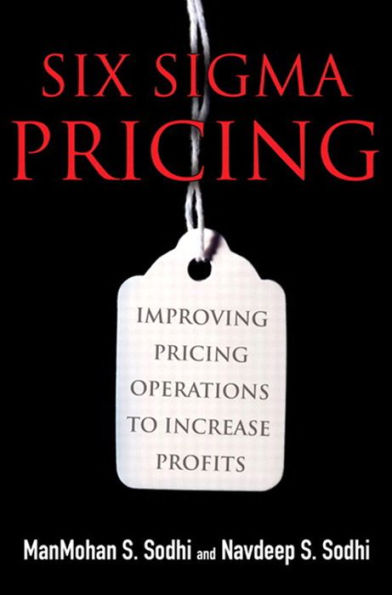Apply Six Sigma to Your #1 Business Challenge: Pricing
“Six Sigma is well known for having helped companies save billions of dollars. This book is the first to show us how to use it on the revenue side of the equation to generate profitable growth. This step-by-step guide will be an instant classic—a seminal book on a topic critical to profitability.”
—Robert Cross, Chairman and CEO, Revenue Analytics Inc. and author of Revenue Management
“Six Sigma Pricing provides companies with a practical toolkit to improve their price management. The authors show executives how to use Six Sigma tools in their pricing processes and instantly improve profits and their bottom-line. This is a truly ‘must-have’ resource for managers everywhere.”
—Eric Mitchell, President, Professional Pricing Society
Many companies have developed solid sales strategies– but without equally good pricing operations, those strategies alone will not add a dime to the bottom line.
The goal of pricing operations is to consistently control price deviations in transactions and contracts over time and across customer segments. This goal of ensuring the prices are not too low or too high in different transactions relative to guidelines lends itself perfectly to Six Sigma. Using the authors’ breakthrough Six Sigma-based approach, you can systematically eliminate pricing-related revenue leaks, driving higher profits without alienating customers. You’ll learn how to define pricing “defects,” gather and analyze relevant pricing data, review pricing-agreement processes, identify and control failures, implement improvements, and then ensure continuous, ongoing improvement in price, profits and customer satisfaction.
The book reflects the authors’ pioneering experience implementing Six Sigma pricing. Whether you’re a business leader, strategist, manager, consultant, or Six Sigma specialist, it will help you or your client recover profits that have been slipping through the cracks in pricing operations.
•Learn why Six Sigma Pricing makes sense
Why you should target pricing operations, and how to do it
• Identify profit leaks from inefficient pricing operations
Why “sloppy pricing” occurs, how to find it, and how to root it out
• Illuminate your current pricing processes, so you can improve them
Understand your market-facing and internally focused pricing processes pertaining to product launch and lifecycle price management, price increases due to escalation in costs of raw materials, promotions, and discounting
• Set up your pricing operations for continuous improvement in line with your pricing and sales strategy
Use Six Sigma to improve and control processes, ensuring alignment with agreed-upon strategy for pricing and sales
• Create an organization that is successful at pricing
Align different functions and levels of the company to achieve targeted profits
Apply Six Sigma to Your #1 Business Challenge: Pricing
“Six Sigma is well known for having helped companies save billions of dollars. This book is the first to show us how to use it on the revenue side of the equation to generate profitable growth. This step-by-step guide will be an instant classic—a seminal book on a topic critical to profitability.”
—Robert Cross, Chairman and CEO, Revenue Analytics Inc. and author of Revenue Management
“Six Sigma Pricing provides companies with a practical toolkit to improve their price management. The authors show executives how to use Six Sigma tools in their pricing processes and instantly improve profits and their bottom-line. This is a truly ‘must-have’ resource for managers everywhere.”
—Eric Mitchell, President, Professional Pricing Society
Many companies have developed solid sales strategies– but without equally good pricing operations, those strategies alone will not add a dime to the bottom line.
The goal of pricing operations is to consistently control price deviations in transactions and contracts over time and across customer segments. This goal of ensuring the prices are not too low or too high in different transactions relative to guidelines lends itself perfectly to Six Sigma. Using the authors’ breakthrough Six Sigma-based approach, you can systematically eliminate pricing-related revenue leaks, driving higher profits without alienating customers. You’ll learn how to define pricing “defects,” gather and analyze relevant pricing data, review pricing-agreement processes, identify and control failures, implement improvements, and then ensure continuous, ongoing improvement in price, profits and customer satisfaction.
The book reflects the authors’ pioneering experience implementing Six Sigma pricing. Whether you’re a business leader, strategist, manager, consultant, or Six Sigma specialist, it will help you or your client recover profits that have been slipping through the cracks in pricing operations.
•Learn why Six Sigma Pricing makes sense
Why you should target pricing operations, and how to do it
• Identify profit leaks from inefficient pricing operations
Why “sloppy pricing” occurs, how to find it, and how to root it out
• Illuminate your current pricing processes, so you can improve them
Understand your market-facing and internally focused pricing processes pertaining to product launch and lifecycle price management, price increases due to escalation in costs of raw materials, promotions, and discounting
• Set up your pricing operations for continuous improvement in line with your pricing and sales strategy
Use Six Sigma to improve and control processes, ensuring alignment with agreed-upon strategy for pricing and sales
• Create an organization that is successful at pricing
Align different functions and levels of the company to achieve targeted profits

Six Sigma Pricing: Improving Pricing Operations to Increase Profits
288
Six Sigma Pricing: Improving Pricing Operations to Increase Profits
288
Product Details
| ISBN-13: | 9780132703611 |
|---|---|
| Publisher: | Pearson Education |
| Publication date: | 09/17/2007 |
| Sold by: | Barnes & Noble |
| Format: | eBook |
| Pages: | 288 |
| File size: | 1 MB |
| Age Range: | 18 Years |
